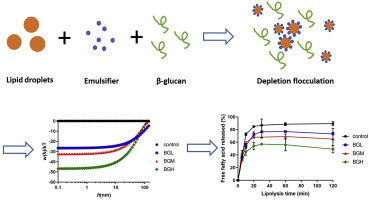当前位置:
X-MOL 学术
›
Food Hydrocoll.
›
论文详情
Our official English website, www.x-mol.net, welcomes your
feedback! (Note: you will need to create a separate account there.)
Barley β-glucan effects on emulsification and in vitro lipolysis of canola oil are modulated by molecular size, mixing method, and emulsifier type
Food Hydrocolloids ( IF 11.0 ) Pub Date : 2020-06-01 , DOI: 10.1016/j.foodhyd.2020.105643 Honglei Zhai , Purnima Gunness , Michael J. Gidley
Food Hydrocolloids ( IF 11.0 ) Pub Date : 2020-06-01 , DOI: 10.1016/j.foodhyd.2020.105643 Honglei Zhai , Purnima Gunness , Michael J. Gidley

|
The purpose of this study was to examine the impact of mixing methods, emulsifier types and molecular weights of barley β-glucan (BG) on emulsification and in vitro lipolysis of canola oil-in-water emulsions. Three different emulsifiers, Triton x100 (TTN), lecithin (LCN) and whey protein isolate (WPI), and three orders of mixing high molecular weight barley BG with oil and emulsifier were studied by measuring viscosity, microstructure and particle size distribution of the systems; while extent of lipolysis was quantified by an in vitro digestion method. In addition, lipids initially emulsified with TTN were mixed with barley BG of low, medium and high molecular weight to determine the effect of BG molecular weight on canola oil emulsion structure and lipolysis. In the absence of barley BG, lipid emulsification depended on the emulsifier type with larger lipid droplets found in WPI stabilized emulsions. Incubating emulsions with fibres increased the viscosity and size of the emulsified droplets, but to different extents depending on the emulsifier type and mixing order. Addition of BG reduced lipid digestion to the greatest extent for initially small droplet sizes, but independent of viscosity. Microstructure and particle size analysis suggest that the mechanism involves droplet flocculation restricting the surface area available for lipase action. Changes in droplet size distribution were observed after digestion only for high molecular weight BG, with more large droplets. All BG samples slowed lipolysis of emulsions but to different extents depending on the molecular weight with the largest BG significantly reducing lipolysis (p < 0.05). A rationalization is proposed for the impact of different molecular weights of barley BG on the depletion flocculation of emulsions using two models. These results enhance our understanding of the impact of soluble dietary fibres on the physicochemical and structural changes that may occur to emulsified lipids within the gastrointestinal tract.
中文翻译:

大麦 β-葡聚糖对菜籽油乳化和体外脂肪分解的影响受分子大小、混合方法和乳化剂类型的调节
本研究的目的是检查大麦 β-葡聚糖 (BG) 的混合方法、乳化剂类型和分子量对菜籽油水包油乳液的乳化和体外脂肪分解的影响。通过测量系统的粘度、微观结构和粒度分布,研究了三种不同的乳化剂 Triton x100 (TTN)、卵磷脂 (LCN) 和乳清蛋白分离物 (WPI),以及高分子量大麦 BG 与油和乳化剂的三种混合顺序; 而脂肪分解的程度则通过体外消化方法进行量化。此外,将最初用 TTN 乳化的脂质与低、中和高分子量的大麦 BG 混合,以确定 BG 分子量对菜籽油乳液结构和脂解的影响。在没有大麦BG的情况下,脂质乳化取决于乳化剂类型,在 WPI 稳定的乳液中发现具有较大的脂滴。将乳液与纤维一起孵育会增加乳化液滴的粘度和大小,但在不同程度上取决于乳化剂类型和混合顺序。对于最初的小液滴尺寸,添加 BG 最大程度地减少了脂质消化,但与粘度无关。微观结构和粒度分析表明,该机制涉及液滴絮凝,限制了可用于脂肪酶作用的表面积。仅在高分子量 BG 消化后观察到液滴尺寸分布的变化,具有更大的液滴。所有 BG 样品都减缓了乳液的脂肪分解,但在不同程度上取决于分子量,最大的 BG 显着降低了脂肪分解(p < 0.05)。使用两种模型对不同分子量的大麦 BG 对乳液消耗絮凝的影响提出了合理化建议。这些结果增强了我们对可溶性膳食纤维对胃肠道内乳化脂质可能发生的物理化学和结构变化的影响的理解。
更新日期:2020-06-01
中文翻译:

大麦 β-葡聚糖对菜籽油乳化和体外脂肪分解的影响受分子大小、混合方法和乳化剂类型的调节
本研究的目的是检查大麦 β-葡聚糖 (BG) 的混合方法、乳化剂类型和分子量对菜籽油水包油乳液的乳化和体外脂肪分解的影响。通过测量系统的粘度、微观结构和粒度分布,研究了三种不同的乳化剂 Triton x100 (TTN)、卵磷脂 (LCN) 和乳清蛋白分离物 (WPI),以及高分子量大麦 BG 与油和乳化剂的三种混合顺序; 而脂肪分解的程度则通过体外消化方法进行量化。此外,将最初用 TTN 乳化的脂质与低、中和高分子量的大麦 BG 混合,以确定 BG 分子量对菜籽油乳液结构和脂解的影响。在没有大麦BG的情况下,脂质乳化取决于乳化剂类型,在 WPI 稳定的乳液中发现具有较大的脂滴。将乳液与纤维一起孵育会增加乳化液滴的粘度和大小,但在不同程度上取决于乳化剂类型和混合顺序。对于最初的小液滴尺寸,添加 BG 最大程度地减少了脂质消化,但与粘度无关。微观结构和粒度分析表明,该机制涉及液滴絮凝,限制了可用于脂肪酶作用的表面积。仅在高分子量 BG 消化后观察到液滴尺寸分布的变化,具有更大的液滴。所有 BG 样品都减缓了乳液的脂肪分解,但在不同程度上取决于分子量,最大的 BG 显着降低了脂肪分解(p < 0.05)。使用两种模型对不同分子量的大麦 BG 对乳液消耗絮凝的影响提出了合理化建议。这些结果增强了我们对可溶性膳食纤维对胃肠道内乳化脂质可能发生的物理化学和结构变化的影响的理解。











































 京公网安备 11010802027423号
京公网安备 11010802027423号